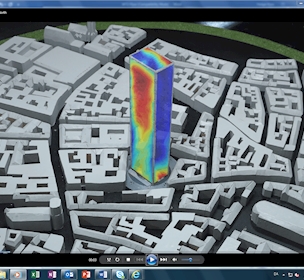Pedestrian wind comfort in urban areas
Placing a building or in other ways changing a built-up area will have an impact on the wind flow. In order to ensure the usability of the surrounding environment, architects and engineers need to address the wind comfort of the area.
The wind comfort of a given area is found by using wind statistics, aerodynamic information and comfort criteria.
A pleasant wind environment around a structure or at a site can prove to be the key to its success. By using detailed models, wind-tunnel testing or numerical methods, it is possible to assess the wind comfort of a site for pedestrians, the dispersion of gases and plumes, the wind climate around buildings, stadiums and cafés and the dispersion of e.g. snow, pollen and rain.
Improvement of local wind comfort
The following steps are taken when it is found necessary to improve the local wind environment:
- Detecting critical areas of undesirable wind comfort
- Identification of the cause of undesirable wind comfort
- Optimisation of wind comfort suiting the requirements for city life and commercial usage
Pedestrian level wind flow
An investigation of the pedestrian level wind field provides the basis for an understanding of possible shortcomings in wind comfort conditions in built-up areas. For this purpose, various techniques can be employed depending on the applicability of each for the particular case.
Information on the flow field, i.e. the characteristics of the wind flow around the structures, is indispensable for the evaluation of counter measures to improve the existing wind comfort. For large areas, erosion tests are well-suited to give an overall picture of the wind conditions. For specific locations, the flow field characteristics are found by flow measurements at the given point.
In combination with studies of the local flow field, erosion tests give a detailed description of the ground-near wind conditions affecting pedestrian activities to different extents. Flow direction, level of shelter or exposure to wind and the measured characteristics of the turbulent wind give a complete set of information on the local pedestrian level wind flow. Thus, when studying pedestrian wind comfort, exposed and sheltered areas, e.g. at the base of a building or at a recreational area, are identified and quantified.
Wind statistics and comfort criteria
For a complete picture of the wind comfort in a particular area, several wind directions should be investigated. The results for each direction are combined using the meteorological data of the local wind climate.
Combining the local wind climate statistics with the measurements of the local wind field, the resulting wind comfort conditions can be mapped for the area of interest. A discussion of improvements will be based on the results of the entire investigation.
Measuring the flow characteristics at various points allows for the quantification of the wind climate, which generates the wind comfort felt by people. Measuring points may be located at positions for street cafés and shopping streets but also at building entrances, parks or other public spaces.



